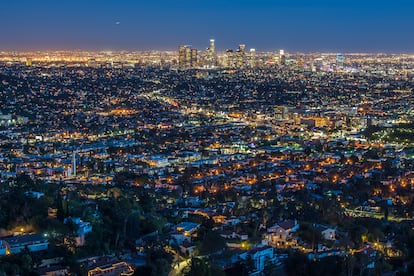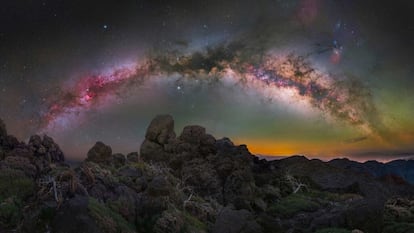Nighttime lighting is harmful to human health
Recent studies show that light pollution affects the secretion of melatonin, alters the circadian rhythm and disrupts the intestinal microbiome

For at least a decade, the amount of artificial light that shines at night has been increasing by almost 10% a year. Today, light pollution barely lets us see the stars, making it difficult for astronomers to carry out their work. In the animal kingdom, male fireflies can no longer find females in regions close to cities, and some fish in tourist areas emerge and approach the beach, thinking that the day has begun. As for the humans, in addition to missing the aesthetic value of contemplating a starry sky, how does nighttime light affect our health?
This week, the journal Science published a special edition focused on light pollution with half a dozen papers that review what science knows about its many, varied impacts. The review cites, for instance, how most of the planet’s telescopes are no longer able to see the sky the way they did just a few years ago. It also mentions a work from 2020 that showed how artificial light was disrupting animal life. One of the mechanisms of this disturbance has to do with a hormone that humans share with practically all living beings: melatonin. This hormone intervenes in the biological clock, increasing its production and release at dusk and reducing it when the day begins, inducing sleep or awakening.
The results of an experiment with 100 people exposed to artificial light, published in December 2022, show the mechanics of the relationship between excess lighting and melatonin suppression. The primary way by which the body knows that night is approaching and that it is time to sleep are the eyes, and the amount of light that enters through them. The photoreceptors in the retina take care of that. The best known are the cones and the rods (the former allow us to see the world in color, the latter work like night vision goggles), but there are other photosensitive cells that were discovered a century ago, but whose functions science is only just beginning to understand: intrinsically photosensitive retinal ganglion cells (ipRGCs), which are especially sensitive to the blue part of the light spectrum. The experiment with these hundred people confirmed that both the cones and the ipRGCs do more than just help us see; they are also responsible for activating or short-circuiting the release of melatonin, affecting the circadian rhythm.
The problem is that not many works analyze the connection between light pollution and human health. Most of them — like the one with 100 people — were carried out in laboratories or with night workers who were mostly exposed to indoor lighting. In this segment of the population, a higher incidence of cardiovascular diseases and cancer has been found. However, the impact of streetlights under real conditions is only now becoming known.
One of the few experiments, the results of which were published last year, involved drivers, pedestrians and people inside their homes exposed to the light of streetlights that had recently been converted to LED technology. The researchers measured the levels of melatonin in their saliva and found no significant differences in melatonin suppression in the three groups. However, another study carried out in a New York neighborhood in the summer of 2018, in which the participants wore an activity bracelet, detected an altered circadian rhythm. In the study’s conclusions, the authors noted that individuals living in urban environments darkened their days and brightened their nights. The problem with both studies is that they were carried out with very small samples — one with 29 people, the other with 23 — which makes it difficult to generalize their results.
Another way in which light pollution impacts the circadian clock that governs the day/night cycle comes from a newly discovered factor: the microbiome. It was known that the intestinal microbiota follows, and is partly the protagonist of, the circadian rhythm, increasing or decreasing the abundance of certain species depending on the time of day. Last year, researchers from the National Taiwan University published a striking result, albeit in mice. When exposed to artificial light at night, they detected abnormal activity of ipRGCs cells (the aforementioned retinal photoreceptors) and a correlative change in the intestinal microbiota of the rodents. And there is increasing evidence that human health largely depends on the state of its microbiome, particularly in the gut.

ISGlobal researcher Barbara Harding studies circadian rhythm disturbances and their health consequences as part of a group led by epidemiologist Manolis Kogevinas, who is in charge of the institution’s cancer program. “We are studying the impact of light pollution on cardiovascular health,” she says. The first results of that work, still unpublished, show that excess lighting “has an effect on hypertension and obesity.” This same group led another work, published in 2018, that correlated excessive exposure to artificial light, particularly blue light from LEDs, with some types of cancer.
One scientist who has devoted much time to the research of light pollution is Cristopher Kyba, from the German Research Center for Geosciences in Potsdam, Germany. Kyba is not an expert on health impacts, but notes that there is “plenty of evidence that people who live in areas with brighter lighting tend to have poorer health outcomes, and for many of these (for example, breast cancer, metabolic syndrome), a connection to light exposure is known to exist.” However, Kyba acknowledges that, although light pollution has been shown to alter the lives of the other living things, “it has not been clearly shown whether outdoor lighting directly contributes or causes these impacts on human health, rather than simply being correlated with some other factor that also has an impact.”
Sign up for our weekly newsletter to get more English-language news coverage from EL PAÍS USA Edition
Tu suscripción se está usando en otro dispositivo
¿Quieres añadir otro usuario a tu suscripción?
Si continúas leyendo en este dispositivo, no se podrá leer en el otro.
FlechaTu suscripción se está usando en otro dispositivo y solo puedes acceder a EL PAÍS desde un dispositivo a la vez.
Si quieres compartir tu cuenta, cambia tu suscripción a la modalidad Premium, así podrás añadir otro usuario. Cada uno accederá con su propia cuenta de email, lo que os permitirá personalizar vuestra experiencia en EL PAÍS.
¿Tienes una suscripción de empresa? Accede aquí para contratar más cuentas.
En el caso de no saber quién está usando tu cuenta, te recomendamos cambiar tu contraseña aquí.
Si decides continuar compartiendo tu cuenta, este mensaje se mostrará en tu dispositivo y en el de la otra persona que está usando tu cuenta de forma indefinida, afectando a tu experiencia de lectura. Puedes consultar aquí los términos y condiciones de la suscripción digital.
More information
Últimas noticias
Nazareth Castellanos, neuroscientist: ‘We need to teach anxiety prevention techniques from school onwards’
Oona Chaplin: ‘I told James Cameron that I was living in a treehouse and starting a permaculture project with a friend’
Madrid, the second region in Europe with the most roundabouts thanks to urban speculation: One for every 30 intersections
Amy Taylor, singer of Amyl and the Sniffers: From selling nuts to opening for AC/DC
Most viewed
- Charles Dubouloz, mountaineering star, retires at 36 with a farewell tour inspired by Walter Bonatti
- CBS in crisis after pulling a report on Trump’s deportations to El Salvador (which later leaked online)
- December Social Security and SSI payments: Dates, double checks and the 2026 COLA increase
- Venezuela faces its most tense Christmas yet
- Bukele clan fumes over investigation exposing their new wealth











































